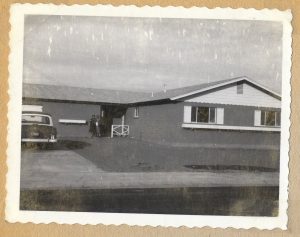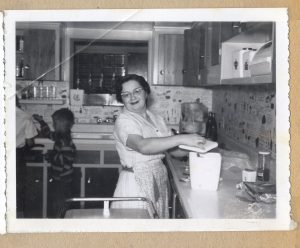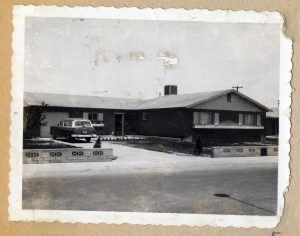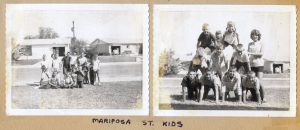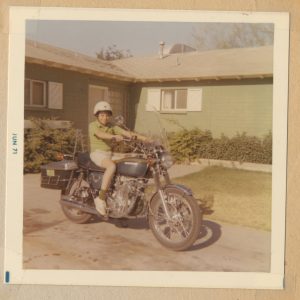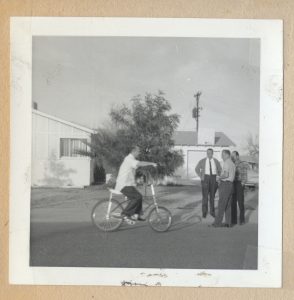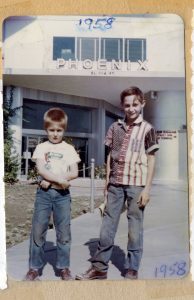- Slug: BC-CNS-Maryvale Transformation. 3,035 words.
- 7 photos, video available.
- Clients who use this package must include the About section at the end of the text and a link back to the original project. Questions should be directed to New Media Innovation and Entrepreneurship Lab director Retha Hill at Retha.Hill@asu.edu.
By Jeffrey Horst
Cronkite School Innovation Lab
PHOENIX – Maryvale once epitomized the American dream of suburban family life. During the post-war building boom, a local boy back from the Army transformed acres of farmland west of Phoenix into Arizona’s first planned community.
Maryvale, which now stretches from Grand Avenue to 99th Avenue, Camelback to McDowell roads, had it all when it opened in 1955: modern ranch houses that former G.I.s could afford, new schools within walking distance, a slick open-air mall and plenty of recreation for children and parents alike. It was built in an era when cars were king and gasoline sold for pennies.
John F. Long, who named the subdivision after his wife, marketed it to young families looking to settle down. Long brought in celebrities and actors, including future President Ronald Reagan and comedic legend Buster Keaton, to hawk the development in short promo films and at a showcase called “The Greatest Home Show on Earth.”
People lined up for blocks to see the stylishly appointed model homes and sign up for a mortgage. So many people bought into Maryvale that Long at one point was the third-largest homebuilder in the world.
Maryvale Shopping City, which opened in 1959, was the largest mall west of Dallas at the time.
But the dream didn’t last. For decades, toxic chemicals had spread under Maryvale, leaking from an industrial complex at 35th Avenue and Osborn Road. That set off years of illness, decline and demographic shifts for the neighborhood, which today is both loved and lamented.
It is the most densely populated of Phoenix’s 15 “urban villages,” each of which has its own planning committee. City planners are eyeing a section of Maryvale Village for a makeover, to create a place where people once again will flock to. Instead of relying on a vehicle, residents in the planned village core would have access to a new light rail line and could walk to shops and parks.
How Maryvale grew and transformed also speaks volumes about Phoenix’s growth from a sleepy desert town to the fifth-largest city in the country.
The beginning of an Arizonan dream
Long returned to the Valley after serving in World War II and married Mary Tolmachoff in 1947. Needing a house for his new family to live in, he built one on 23rd Avenue near Glendale Avenue in Phoenix, which had about 105,000 residents at the time.
Before the family even moved in, Long received offers to sell the house, some more than doubling the $4,200 cost of construction. Long built 15 more homes, and as more people came with offers he couldn’t refuse, his homebuilding career was launched.
After selling those first homes, in 1950, Long built more collections in Phoenix, totaling more than 300 homes.
In 1954, Long bought thousands of acres just west of the city, intent on building a master-planned community “where people could live, work and play all within their given area.” He began designing the development with architect Victor Gruen, including areas set out for parks, schools and businesses.
“The reason that I picked this location is that it was all agriculture,” Long said in an interview with the Historical League in 2000. “There (were) no subdivisions within the area, and it gave us the opportunity to do some long-range planning.”
Long began building 20 houses a day in Maryvale, helping to feed a housing market storm. With financial support from the GI Bill, World War II veterans had money to buy a brand new home. By 1956, Long was selling 125 homes a week for about $7,600 each.
The price was a steal. The median price for homes in the U.S. in 1960 was nearly $12,000, and the median income for families in Maryvale was a little more than $5,800 at the time.
For $7,600, Long’s homes came with a garage, a front and backyard, and a pool. Buyers could also have appliances installed upon purchase.
“And they sold, they sold fast,” said Long in the 2000 interview. “Most of the buyers were young veterans. In fact, there’s some of the people, the original buyers that still live there.”
Maryvale, like many of Phoenix’s booming areas, was overwhelmingly white. When Phoenix annexed Maryvale in 1960, only 88 of its 66,000 residents were Black – just 0.01% of the population, according to census data. Racially restrictive real estate covenants and local Phoenix tradition kept most Blacks and Latinos from living north of Van Buren Street.
Phoenix in 1960 was eager to expand its boundaries; it also annexed parts of south Phoenix that year, which, along with the addition of Maryvale, more than doubled the city’s size.
As more people moved to Maryvale, Long created a central hub: the open-air Maryvale Shopping City, which boasted 19 stores and 111,000 square feet of retail space. Tenants included S.S. Kresge’s, where teenagers could stop in for a root beer float, and Malcolm’s, a department store owned by Long.
The $18 million mall also featured a bowling alley, making it a central location to shop, eat and play. Such stars as Jim Backus, who had played the father of James Dean’s character in the iconic film “Rebel Without a Cause,” attended the grand opening of Bowlero to roll a few frames alongside Long.
With 32 lanes, a kids area, a meeting room and cozy, modern seating for those who’d rather watch than bowl, Bowlero served as a family-friendly yet multifunctional event space.
“We’d go to the bowling alley and my dad would drink at the bar, (and) I’d sit up there with him,” said Bobby Luryels, who lived in Maryvale for 31 years. “And at the bar, it had these little stars in the carpet. I thought it was so cool.”
In addition to Bowlero, the skating rink and the community pools, Maryvale became known as the place to hear live music.
Mr. Lucky’s, which opened on Grand Avenue in 1966, was planned as a casino but eventually became a club and music venue, branding itself the “Home of the Stars.” The bustling joint – with a jolly court jester on the sign out front – boasted live music seven nights a week, with bands on two floors, one dedicated to country music and the other to rock.
Bull-riding took place in the nightclub’s parking lot. Country legend Waylon Jennings and rock pioneer Wanda Jackson were among those who found fame at Mr. Lucky’s.
Maryvale grew as people and their families grew. The homes, the shopping and the recreation formed a collective identity.
“John F. Long really created a community that was centered around the people,” said John Jacquemart, who grew up in Maryvale during the 1960s. “If I really think about it, that’s what made Maryvale so special. Everyone gathering around for activities. And Maryvale is part of who I am.”
Another focal point of community life was Maryvale High School, which opened its doors in February 1963 but had started taking students the year before as a guest on the Carl T. Hayden High School campus nearly 8 miles east.
Freshmen, sophomores and juniors moved into the building in ’63, while seniors stayed at Hayden. Students frequently congregated in the courtyards or grabbed a bite to eat at the Cat Cafe on campus.
By 1970, Maryvale’s population had topped 83,000, and the dream continued. But danger lurked below ground.
The cancer cluster
St. Vincent de Paul Elementary School opened in 1959, educating students in kindergarten through fifth grade.
In 1985, the principal of St. Vincent de Paul reported to the Arizona Department of Health Services that 12 former students over the previous 20 years had developed leukemia. And she knew of 16 children from neighboring schools who had developed cancer.
After visiting the school and hurriedly analyzing data collected from 1970 to 1981, ADHS concluded the higher rate of childhood leukemia deaths in west Phoenix was a statistical glitch.
The explanation outraged many in the community. More than 800 people flooded Maryvale High in 1987 to demand studies to find what caused the spike in deaths and to clean up the groundwater beneath their homes. The state created the Department of Environmental Quality the same year to conduct the investigation. Preliminary findings after a year of work revealed more troubling information.
For 16 years starting in 1970, the childhood death rate from leukemia in west Phoenix was double the national average. For every 100,000 children in 1985, 1.39 children died from leukemia in the U.S., according to the National Cancer Institute.
Studies on what caused the leukemia moved slowly. ADEQ took10 years to complete the study, which ultimately found no link between any environmental factors and the Maryvale cancer cluster.
Contaminants found in water and soil samples included trichloroethene (TCE), a known carcinogen, and tetrachloroethene (PCE), also tied to higher risks of cancer and birth defects. Several companies, including United Industrial Corp., which operated in the West Osborn Complex in Maryvale, years later agreed to some remedial cleanup and to pay for state oversight costs.
Lanette Kirk-Veres, who lived in Maryvale until she was 22, was diagnosed with cancer when she was 28. In 1992, her grandmother was diagnosed with brain cancer.
Kirk-Veres, the founder of the Gray Matters Foundation, said she believes “fear, ignorance and big corporate America” led to officials wanting to mask the issues within Maryvale.
“I don’t believe it’s cleaned perfectly, you know … you’re only as good as the people following up on it,” Kirk-Veres said. “You know, who’s out there testing? Where’s the reports?”
In 1987, ADEQ declared Maryvale a superfund site, which are highly contaminated areas that the federal Environmental Protection Agency can help clean.
The department discovered another contamination plume in fall 2021, but officials said they don’t believe anyone in the community has been drinking from wells tapping that groundwater.
Many people left the area in the 1980s and ’90s because of the cancer cluster and other factors. But others stayed in Maryvale because their home values had fallen.
“What are people going to do? They own their home, they can’t afford to move,” Kirk-Veres said. “They can sell their house, but where else can they buy?”
But those who moved out of Maryvale cleared room for members of a displaced community miles away to eventually find a new home.
The destruction of the Golden Gate Barrio
The thousands of people flying into Phoenix throughout the 1960s overburdened regional Phoenix Sky Harbor Airport. Boosters and others saw the airport, which Phoenix had purchased in 1935, as one of the city’s most valuable financial assets.
In 1970, Phoenix approved plans to expand Sky Harbor to the west. The land needed for the expansion included the Golden Gate Barrio, a neighborhood of Mexican American and Hispanic families that was established in the early 1930s, with some living in the area a decade earlier.
To receive federal funds for the expansion, the city was required to complete an environmental impact assessment, which would take a number of years. Golden Gate residents raised concerns about the expansion, from noise pollution to the prospect of losing their homes. To address the concerns, Phoenix formed the West Approach Land Acquisition Project.
Most Golden Gate residents wanted a relocation plan, but they wanted to make sure they would be paid fairly for their land. After years of negotiation, the city and the residents reached an agreement for repayment and relocation.
The city eventually razed the homes of nearly 6,000 families and displaced them over the next decade. One of them was Gilbert Arvizu’s father, who lived in Golden Gate with his own dad. Arvizu’s grandfather, who had stomach cancer at the time the city was knocking down the barrio, held out. The day after Arvizu’s grandfather died, the city razed his home.
The city also purchased Sacred Heart Catholic Church in 1985 and planned to demolish it as well. But the community fought back. Today the brick church is on the National Register of Historic Places, standing alone where the barrio used to be.
“The community helped build the church, it was a community effort,” said Eduardo Barrazo, whose family lived there. “They felt it was something that they really value because they built it themselves.”
Surrounded by a chain link fence, the church opens once a year for Christmas Mass.
Golden Gate residents were dispersed to other Phoenix neighborhoods, including Maryvale, where reports of groundwater pollution had triggered white flight from the neighborhood.
“You’ll see folks who live in Avondale or Maryvale, but they’re posting (online) about their life that they grew up in Golden Gate, because that’s where they grew up,” said Arvizu, an executive board member of the Braun Sacred Heart Center. “And then once the relocation happened, you know, those folks were basically spread throughout the Valley.”
Reckoning with a new future
The displacement of the Golden Gate Barrio would start a demographic shift in Maryvale. In 1970, more than 10,000 people of Hispanic or Latine descent lived in Maryvale. That number doubled by 1980, and nearly doubled again by 1990. By 2000, people of Hispanic and Latino descent outnumbered white people in Maryvale.
Major landmarks in Maryvale also began changing in the 1970s. The Bowlero was reconfigured into Pettett’s Department Store in 1974. In the late 1970s, the name Maryvale Shopping City was changed to Maryvale Mall, and its space was expanded and enclosed.
Westridge Mall, now known as Desert Sky Mall, opened in fall 1981 about 3 miles west of Maryvale Mall. The competition led to the slow decline of Maryvale Mall, which by the mid-1990s was nearly vacant.
Long sold the mall to the Cartwright School District in the late 1990s. The site now is occupied by Marc T. Atkinson Middle School, which opened in 2000.
Crime was another issue the village had to handle during the 1980s and ’90s.
Multiple current and former residents acknowledge that crime in Maryvale rose during those decades. Some people left, and many other communities worked with police and social groups to weed out crime and seed the area with youth programs and job opportunities.
One who stayed is Rosie Espinoza, now wellness administrator at the Cartwright district. Espinoza, who lived in Maryvale in the 1980s, said she felt safe growing up there.
“I mean, if you were an outsider, you wouldn’t feel safe, because you might do something that would get you in some kind of trouble,” Espinoza said. “But when you’re a kid and you grew up here … you know what to do and what not to do.”
The Phoenix Police Department did not respond to questions about crime in Maryvale. A records request sent to the department in early March asking for annual crime statistics for Maryvale Village since 1970 has not been fulfilled.
Mr. Lucky’s kept the music playing during the ’80s and ’90s, but attendance began to dwindle and it ceased operating as a country bar in 2004. Since then, it has housed various businesses and passed from owner to owner. The building has been deteriorating for a number of years, but its hallmark jester sign still stands tall.
But as one music venue died in Maryvale, another one arose. Desert Sky Pavilion, now known as Ak-Chin Pavilion, opened in 1990. Billy Joel performed the venue’s opening show and has since hosted many famous acts, such as Dead & Company, KISS and Prince.
Maryvale added more entertainment options with the opening of Maryvale Baseball Park, now known as American Family Fields of Phoenix, in 1998. The ballpark hosts spring training games for the MLB’s Milwaukee Brewers.
In 2011, Phoenix planners created a plan to improve the “walkability and connectivity” of a section of Maryvale bounded by Thomas and McDowell roads and 75th an 83rd avenues.
The Maryvale Village Core Plan also would provide multi-use housing for the land. But most of the project is coming together slowly.
Sarah Stockham, a member of the Phoenix Planning and Development Department, said much of the project is in the hands of private developers who have yet to break ground. The only major progress to date is the approval of a low-income, multifamily housing development.
Analise Ortiz, a Democrat running for one the legislative district seats representing Maryvale, said affordable housing is one of the biggest issues there. She said she believes a mix of multifamily and single-family housing would help to decrease the cost of housing in Maryvale.
“Whether you are renting an apartment or trying to find a home to buy, it is almost impossible to afford rent, and it’s just not sustainable,” said Oritz, who was born and raised in Arizona. “Many of my neighbors here in Maryvale are really concerned about this. They’re waking up one day, and their landlord is telling them that they need to pay 500, 600 extra dollars each month. It’s wrong, and we need urgent solutions.”
Some residents in the area don’t believe building more housing will solve increasing prices.
“I don’t see any benefit in starting housing really anywhere in Arizona at this point in time,” Saul Uriah Gallego said. “There’s going to be a water shortage, there’s going to be a food shortage, resources are already spread too thin. Adding more residency isn’t doing anything, rent’s too high, people aren’t in the houses that are here.”
Michael Angulo, director of policy and research for city councilwoman Betty Guardado, said Maryvale is “the future of Arizona” with many developments taking place throughout the area and with the area’s large, young and diverse population.
“We see just the really just incredible potential that the (Maryvale) village residents have,” Angulo said. “So, whenever we talk about Maryvale, we’re always talking about framing it in … thinking about Arizona’s future.”
Most residents who either live or used to live in Maryvale expressed a fondness for the area. While current and former residents acknowledged Maryvale’s flaws, some said the neighborhood helped form who they are and believe Maryvale was a special place to live.
“I always had fun memories of growing up there as a kid, it was just, we all had a fun, good time there,” Dan Mulleneaux recalled. “I just think my fondest memories of Maryvale was simply the people, I mean at least in my neighborhood and even outside of my neighborhood.”
About:
The Maryvale project was completed in the Fall 2021 and Spring 2022 semesters at the Walter Cronkite School of Journalism and Mass Communication at Arizona State University. The story was written by Jeffrey Horst and reported by the students listed below:
- Stacy Brinson-Anders
- Erin Brassey
- Christopher Dorch
- Garrie Ester
- Tracey Garrett
- Jeffrey Horst
- Max Muehlhausen
- Roman Micucci
- Kaitlyn Ourada
- Kaleigh Strong
- Whitney Whitlock
Cronkite Faculty
Retha Hill, Director of the New Media Innovation and Entrepreneurship Lab
Special thanks to 3DXR designer Laurie Annis
